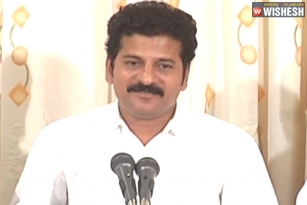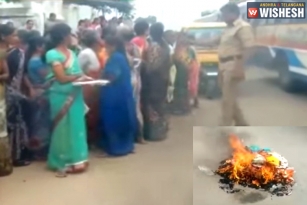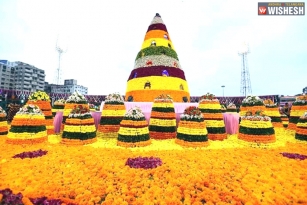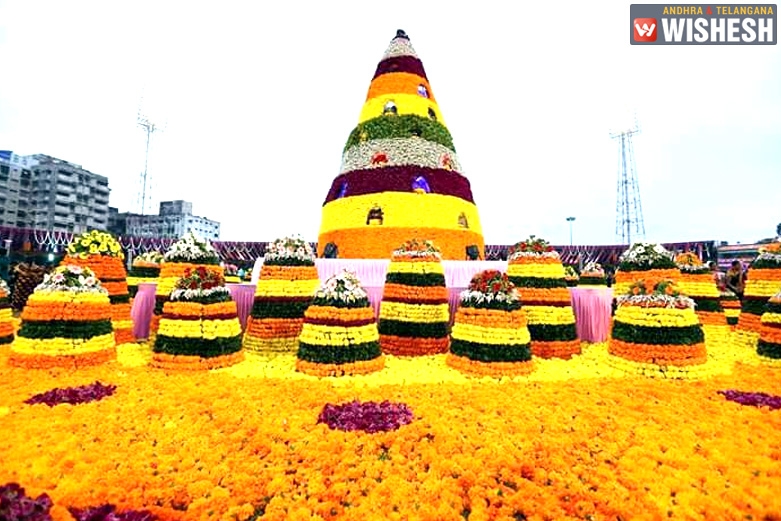
Bathukamma - Telangana’s Floral Festival:- A colorful and vibrant festival of Telangana is the Bathukamma festival, that is celebrated by women, with flowers that grow exclusively in each region. This festival is a symbol of Telangana’s cultural identity.
Bathukamma comes during the latter half of monsoon, before the onset of winter. The monsoon rains usually brings plenty of water into the fresh water ponds of Telangana and it is also the time when wild flowers bloom in various vibrant colors all across the uncultivated and barren plains of the region.

The most abundant of these are the ‘gunuka poolu’ and ‘tangedu poolu’. There are other flowers too like the banti, chemanti, nandi-vardhanam etc. Bathukamma is celebrated by the women folk of Telangana, heralding the beauty of nature in vibrant colors of multitudinous flowers.
The festival starts a week before the grand ‘Saddula Bathukamma’ (the grand finale of the Bathukamma festival) which falls two days before Dussehra. The women folk normally get back to their parent’s home from their in-laws and breathe the fresh air of freedom to celebrate the colors of flowers. For one complete week, they make small ‘Bathukammas’, play around them every evening and immerse them in a nearby water pond.

(Image Source: Bathukamma)
On the last day, the men folk of the house go into the wild plains and gather the flowers like gunuka and tangedi. They bring home bagfuls of these flowers and the entire household sits down to make the big ‘Bathukamma’. The flowers are carefully arranged row after row in a brass plate (called taambalam) in circular rows and in alternate colors.
As evening approaches, the women folk dress colorfully with the best of their attire and adorn lot of ornaments and place the Bathukamma in their courtyard. The women of neighborhood also gather in a large circle around it. They start singing songs by circling it repeatedly, building a beautiful human circle of unity, love, sisterhood.

(Image Source: V6 English news Portal)
After playing in circles around the “Bathukammalu”, before the onset of dusk, the women folk carry them on their heads and move as a procession towards a bigger water body near the village or town. The procession is extremely colorful with the decorations of women and the “Bathukammalu”. Songs of folklore are sung in chorus throughout the procession and the streets resonate with them.
Finally, when they reach the water pond the “Batukammalu” are slowly immersed into water after some more playing and singing. Then they share the ‘maleeda’ (a dessert made with sugar or raw sugar and corn bread) sweets amongst the family members and neighborhood folks. They return to their homes with empty ‘taambaalam’ singing songs in praise of Bathukamma. The songs of Bathukamma echo in the streets until late night during the entire week.
Bathukamma celebrates the inherent relationship between earth, water and the human beings. During the entire preceding week, women make ‘boddemma’ (a deity of Gowri – mother Durga – made with earthly mud) along with Bathukamma and immerse it in the pond. This helps reinforce the ponds and helps it retain more water. The flowers used in Bathukamma have a great quality of purifying water and such flowers when immersed in abundance into the pond have the effect of cleansing the water and making the environment much better.
The festival heralds the beauty of nature, collective spirit of Telangana people, the indomitable spirit of women folks and also the scientific approach of the agrarian people towards preserving the resources of nature in a celebrative way. Hence, Bathukamma is the icon of cultural identity of Telangana.
- History Of Bathukamma
According to the Hindu religious scholars and pundits, once upon a time there was a King named Dharmangada who belonged to the Chola Dynasty. This particular king largely ruled over South India. His wife gave birth to a girl child after many years of rituals and prayer. She was named as Princess Lakshmi.
During Baby Lakshmi upbringing, she survived many unforeseen accidents and incidents in life. The parents felt life and death while bring up their only child. Later they named their daughter as Bathukamma. According to the Telugu language, Bathuku means life and Amma means a female names and mother.
Then on this particular Bathukamma festival is grandly celebrated by young girls in Telangana region in India. The main purpose of this particular festival is to pray with devotion to the Goddess in the strong belief that all young girls would get their beloved husbands as per their desire and wish soon.
On the other hand, married women along with their household friends and relatives celebrate this festival in order to pray to the Goddess for prosperity and good health of their family. This particular festival is primarily celebrated by unmarried young girls who are in the marriageable age.
On the other hand men folks along with their wife’s and other family members, relatives and friends help in the gathering of flowers and floral arrangement of a beautiful flower stack during the festival season.
Bathukamma festival has many myths behind its festivity. According to the Hindu religious scholars and pundits, one myth regarding Goddess Gauri is that she after a fierce fight killed ‘Mahishasura’ the demon. After this serious act, she went into deep sleep due to fatigue on the ‘Aswayuja Padyami’ day. All the Hindu religious devotees strongly prayed with devotion and dedication for her to wake up. It is to be noted that she woke up on the Dasami day.
The other version of Bathukamma is that there was a king named Dharmangada and a queen named Satyavati belonging to Chola Dynasty. They lost their hundred sons in the war front. So they prayed and performed ritual to Goddesses Lakshmi to be born as their daughter. The Goddesses heard it and immediately obliged them. On her birth, many scholar and pundits visited the baby at the royal palace and blessed her by calling Bathukamma or live forever.
While another version says that Parvathi or Batakamma is a adherent lover of flowers. The seasonal flowers of spring are arranged on a square bamboo frame or square wooden plank with the size of frames that is hardly tapering off to directly form a pinnacle on the top. It looks like the shape of a temple tower or ‘Gopura’. On top of the flowers, a lump of turmeric is kept. The worship of Goddess Batakamma is done with this little floral is mountain.
This festival belongs to the women folk of Telangana region. Then men and children participate with lot of interest and enthusiasm in this festivity. The young unmarried girls play a active role in this festival.
- Bathukamma Procedure

To make the beautiful flowers carpet for Bathukamma , if any of the flowers specifically mentioned below; like ‘Gummadi Puvvu’ (Pumpkin flower), ‘Thangedu’ and ‘Gunugu Puvvulu’ (flowers) and ‘Gummadi Aakulu’(leaves of a Pumpkin plant) are not available; you may arrange Bathukamma with which ever flowers you can procure.
- You will have to procure suitable quantity and types of flowers, depending on the size of Bathukamma you want to arrange.
- Pick up a suitable round steel or a brass plate with a small edge. The Bathukamma can be arranged on a 12 inch plate. You can arrange Bathukamma on an 8 inch plate or even a smaller one, for first attempt.
- Lay two pieces of thread on the plate perpendicular to one another and passing over the centre of the plate. These threads should belong enough , so that after arranging the entire Bathukamma in a conical pattern, these threads are drawn upwards and tied at the top to hold the Bathukamma intact.
- Over the plate and the threads, place a ‘Vistharaku’ (a plate made out of leaves). And trim the edges of the ‘Vistharaku’ to match the circular base of the metal plate.
- Spread a thin layer of Pumpkin leaves over the ‘Vistharaku’.
- Arrange one layer of ‘Thangedu Puvvulu’ (Thangedu flowers).These tiny yellow flowers with green buds and leaves and long stems are available at the time of Bathukamma festival.
- The next layer of flowers is with Gunugu Puvvulu’. ‘Gunugu’ flowers with long stems running almost upto the centre of the plate are now arranged radially. You can arrange the row of‘Gunugu’ flowers to any reasonable width taking care that the layer is gradually tapering to finally give a conical shape to Bathukamma. The protruding parts of the ‘Gunugu Puvvulu’ can be trimmed.
- The hollow that is forming at the centre as you are radially arranging the flowers can be filled with Pumpkin leaves,or any other leaves or loose flowers.
- Subsequent top layers/rows may be arranged with any colorful flowers like yellow and orange ‘Banthi Puvvulu’ (Marigold flowers), ‘Chamanthi Puvvulu’ (Chrysanthemum flowers)and any other colorful flowers and even with some artificially colored flowers specially made available for Bathukamma festival. If the flowers do not have stems or the stems are not strong enough,pieces of broomsticks are inserted into the flowers to act as stems and help in arranging and holding the flowers together.
- At the very top, a Pumpkin flower is placed.
- Finally the loose ends of the two threads placed over the bottom plate and under the ‘Vistharaku’ are drawn up and tied at the top to hold the ‘Vistharaku’ and the flowers arranged over it (Bathukamma)in position. Towards the end of Bathukamma celebrations, Bathukamma is given a traditional farewell (‘Saaganampadam’) by placing Bathukamma over a water body -a river or lake.
- Bathukamma is placed over the surface of water and the plate on which it is arranged is cautiously taken out.
Our colorful Bathukamma now standing on the ‘Vistharaku’ can be seen graciously floating. Watching hundreds of families dressed in their best attire and happily playing colorful Bathukammas of different sizes along the shore and then seeing countless Bathukammas floating and dancing with the waves in the lake or river is a very grand and happy sight, beyond description.
(Video Source: Latha Channel)
- Bathukamma Ritual
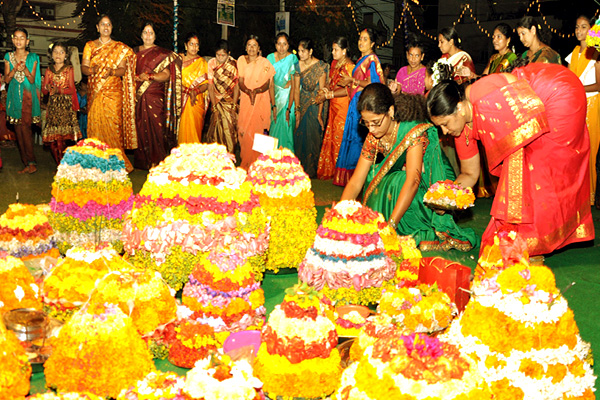
(Image Source: Festival Sherpa)
For the nine days, in the evening, women, especially young girls, gather in large numbers with their Bathukammas in open areas of their locality. All women will form a circle around the Bathukamma and start singing folk songs by clapping their hands and revolving around the Bathukamma, synchronizing steps and claps in unison provide a splendorous look to the festivities. Women seek good health, prosperity and happiness for their families. The songs are to invoke the blessings of various goddesses. By principle, the rendition end with any one of the following three tributes Uyyaala,Chandamama or Gouramma.
Bathukamma comes during the latter half of monsoon, before the onset of winter. The monsoon rains usually brings plenty of water into the fresh water ponds of Telangana and it is also the time when wild flowers bloom in various vibrant colors all across the uncultivated and barren plains of the region. The most abundant of these are the ‘gunuka poolu’ and ‘tangedu poolu’. There are other flowers too like the banti, chemanti, nandi-vardhanam etc. Bathukamma is celebrated by the women folk of Telangana, heralding the beauty of nature in vibrant colors of multitudinous flowers.
Each day has a name mainly signifying the type of “naivedyam” (food offering) offered. Most of the naivedyam (food offering) offered are very simple to prepare, and usually young children or young girls are mainly involved in the preparation of the offerings for the first eight days of the festival. The last day, called saddula Bathukamma is when all the women take part in the preparation.
Following is the list of names for each day and the naivedyam offered on that day.
1) Engili Pula Bathukamma
The first day of the festival falls on Mahalaya Amavasya, also known as Pethara Amavasya in Telangana region. Food offering/Naivedyam: Nuvvulu (Sesame seeds) with biyyampindi (rice flour) or nookalu (coarsely ground wet rice).
2) Atkula Bathukamma
The second day is called Atkula bathukamma, falls on the Padyami (first day) of Ashwayuja masam. Food offering/Naivedyam: Sappidi pappu (Bland boiled lentils), Bellam (jaggery), and atkulu (flattened parboiled rice)
3) Muddapappu Bathukamma
The third day of Bathukamma falls on Vidiya/second day of Ashwayuja masam. Food offering/Naivedyam: muddapappu (softened boiled lentils), milk and bellam (jaggery).
4) Nanabiyyam Bathukamma
The fourth day falls on thidiya/third day of Ashwayuja masam. Food offering / Naivedyam: nananesina biyyam (wet rice), milk, and bellam (jaggery).
5) Atla Bathukamma
The fifth day falls on the chathurdi/fourth day of Ashwayuja masam. Food offering/Naivedyam: uppidi pindi atlu( pan cakes made from wheatlets), or Dosa.
6) Aligina Bathukamma
The sixth day falls on the panchami/fifth day of Ashwayuja masam. No food offering is made.
7) Vepakayala Bathukamma
The seventh day falls on the sashti/sixth day of Ashwayuja masam. Food offering/Naivedyam: rice flour shaped into the fruits of neem tree is deep fried.
8) Vennamuddala Bathukamma
The eight day falls on sapthami/seventh day of Ashwayuja masam. Food offering/Naivedyam: nuvvulu (sesame), Venna (Butter) or ghee (clarified butter), and bellam (jaggery).
9) Saddula Bathukamma
The ninth day of bathukamma is celebrated on ashtami/eight day of Ashwayuja masam, and coincides with Durgashtami. Food offering/Naivedyam: Five types of cooked rice dishes: perugannam saddi (curd rice), chinthapandu pulihora saddi (tamarind rice), nimmakaya saddi (lemon rice), kobbara saddi (coconut rice) and nuvvula saddi (sesame rice).
SUPRAJA





















